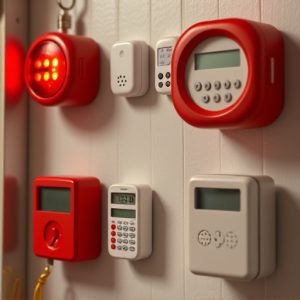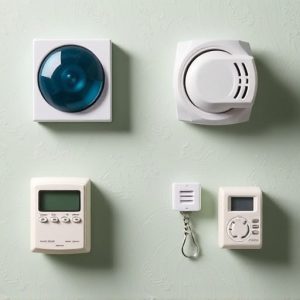Personal Alarm Devices: Custom Volume Adjustments for Safety Empowering Distress Signals
Personal alarm devices, armed with innovative Personal Alarm Volume Adjustment Features, offer a mod…….
Personal alarm devices, armed with innovative Personal Alarm Volume Adjustment Features, offer a modern solution for distress communication. These tools allow users to set custom sound levels, ensuring discretion in private situations while maintaining high volumes for public emergencies. With GPS and cellular connectivity, they notify emergency services and loved ones instantly. The volume adjustments cater to diverse scenarios, empowering individuals to take charge of their safety, from loud alerts in public spaces to subtle reminders in quieter settings. This feature is crucial during medical emergencies, natural disasters, and security threats, enabling prompt and effective responses. However, the integration of tracking devices raises ethical concerns around privacy, consent, data security, and surveillance ethics, necessitating a balance between safety and personal freedom.
Personal distress signals have evolved with modern technology, incorporating tracking capabilities that offer unprecedented safety nets. This article delves into the understanding of these signals, exploring how tracking technology empowers individuals in emergency situations. We’ll dissect the various features of personal alarm devices, focusing on the critical role of volume adjustment settings. By examining customizable volume levels, we uncover benefits that enhance response times and ensure user safety without infringing upon individual freedom, balancing ethical considerations and privacy concerns.
- Understanding Personal Distress Signals: The Modern Approach
- Tracking Technology: A Tool for Safety and Empowerment
- Features of Personal Alarm Devices: Volume Adjustment Explained
- Benefits of Customizable Volume Levels in Emergency Situations
- Ethical Considerations and Privacy Concerns: Balancing Safety with Individual Freedom
Understanding Personal Distress Signals: The Modern Approach
Personal distress signals, in the modern context, go beyond mere shouting for help. With technological advancements, individuals now have access to sophisticated tools that can discreetly and effectively communicate their distress, especially when facing emergencies in remote or public places. These personal alarm devices are designed to be user-friendly, often featuring simple yet powerful mechanisms. One notable aspect is the Personal Alarm Volume Adjustment Features, allowing users to set different sound intensities tailored to specific situations. This ensures a discrete alert for private issues while maintaining high volume for public emergencies, making them versatile and adaptable to various scenarios.
The ability to customize personal alarms encourages proactive self-protection, empowering individuals to stay safe while exploring or traveling solo. Modern approaches to distress signals emphasize the importance of technology in enhancing personal security, offering remote tracking capabilities that can notify emergency services or trusted contacts in real time. This modern twist on traditional distress signals is revolutionizing personal safety measures, providing peace of mind in an increasingly diverse and often unpredictable world.
Tracking Technology: A Tool for Safety and Empowerment
Tracking technology has emerged as a powerful tool for personal safety and empowerment, especially in the context of distress signals. Modern devices go beyond basic alerts by offering sophisticated features like precise location tracking and customizable settings. For instance, personal alarms equipped with GPS and cellular connectivity can instantly notify emergency services and loved ones when triggered, ensuring swift response times.
One key advantage lies in the ability to adjust the alarm’s volume and intensity based on individual preferences and situational awareness. This customization allows users to signal for help discreetly in private settings or make their presence known loudly in public spaces, providing a layer of control over how distress is communicated. Such adjustments cater to diverse scenarios, empowering individuals to take charge of their safety effectively.
Features of Personal Alarm Devices: Volume Adjustment Explained
Personal alarm devices are designed to draw attention and alert others in times of distress, offering a crucial safety net. One of the key features facilitating this is the volume adjustment functionality. By allowing users to set the alarm’s volume level, these devices cater to diverse situations and preferences. This feature ensures that the alarm can be heard clearly in noisy environments or adjusted for more subtle alerts in quieter settings.
The volume adjustment not only amplifies or reduces the sound but also enables users to choose from various ringtones or alarms, adding another layer of customization. Higher volumes are ideal for public spaces or when immediate attention is required, while lower settings can be suitable for personal use at home, ensuring a balance between privacy and alertness. This adaptability makes personal alarm devices versatile tools for self-protection and peace of mind.
Benefits of Customizable Volume Levels in Emergency Situations
In emergency situations, the ability to customize personal alarm volume levels can significantly enhance safety and effectiveness. This feature allows individuals to adjust the sound intensity according to their specific needs and environments, ensuring critical alerts are heard even in noisy or distracting surroundings. Customizable volume levels cater to a diverse range of users, from those with hearing impairments who require higher volumes for clear audibility, to individuals in crowded public spaces where a subtle yet noticeable alarm is preferred.
The Personal Alarm Volume Adjustment Features prove invaluable in scenarios such as medical emergencies, natural disasters, or personal security threats. It enables people to respond promptly and appropriately by providing control over the alarm’s volume, thereby increasing chances of successful outcomes. This tailored approach to alertness empowers users to manage their distress signals effectively, making it a critical component for anyone prioritizing personal safety and well-being.
Ethical Considerations and Privacy Concerns: Balancing Safety with Individual Freedom
In the pursuit of enhancing personal safety, introducing devices with tracking capabilities and distress signal functions raises significant ethical considerations and privacy concerns. On one hand, these tools offer much-needed assistance in emergencies, allowing individuals to discretely seek help when faced with personal distress. Features like personal alarm volume adjustment enable users to tailor their alerts to specific situations, ensuring neighbors or bystanders are notified without causing unnecessary panic.
However, the very nature of such devices invades individual privacy. Continuous tracking and the potential for remote activation raise questions about consent, data security, and surveillance ethics. Users must be fully aware of how their data is collected, stored, and shared while also having control over activating these signals. Balancing safety measures with respect for personal freedom is paramount to ensuring these technologies serve their purpose without infringing on fundamental human rights.
Personal distress signals, now equipped with tracking technology and adjustable volume levels, offer a powerful tool for safety and empowerment. By understanding these modern approaches and addressing ethical considerations, we can ensure that individuals have control over their personal security without compromising privacy. The unique features of customizable volume levels prove invaluable in emergency situations, allowing users to signal for help discreetly or loudly as needed. As this technology advances, it’s crucial to strike a balance between safety measures and individual freedom.


